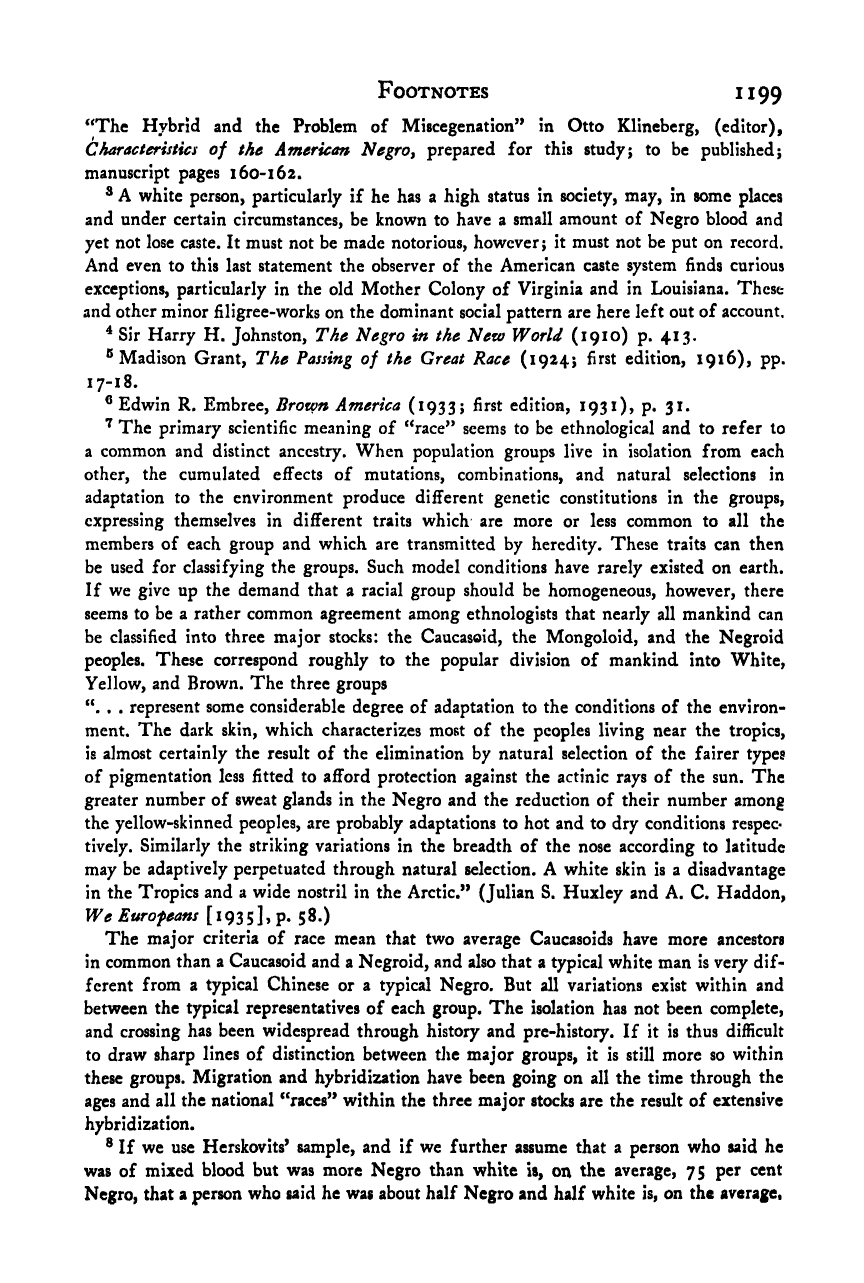Note: Gunnar Myrdal died in 1987, less than 70 years ago. Therefore, this work is protected by copyright, restricting your legal rights to reproduce it. However, you are welcome to view it on screen, as you do now. Read more about copyright.
Full resolution (TIFF) - On this page / på denna sida - Footnotes - Chapter 5

<< prev. page << föreg. sida << >> nästa sida >> next page >>
Below is the raw OCR text
from the above scanned image.
Do you see an error? Proofread the page now!
Här nedan syns maskintolkade texten från faksimilbilden ovan.
Ser du något fel? Korrekturläs sidan nu!
This page has never been proofread. / Denna sida har aldrig korrekturlästs.
Footnotes 1199
‘‘The Hybrid and the Problem of Miscegenation” in Otto Klineberg, (editor),
Characteristics of the American NegrOy prepared for this study; to be published;
manuscript pages 160-162.
® A white person, particularly if he has a high status in society, may, in some places
and under certain circumstances, be known to have a small amount of Negro blood and
yet not lose caste. It must not be made notorious, however; it must not be put on record.
And even to this last statement the observer of the American caste system finds curious
exceptions, particularly in the old Mother Colony of Virginia and in Louisiana. These
and other minor filigree-works on the dominant social pattern are here left out of account.
^ Sir Harry H. Johnston, The Negro in the New World (1910) p. 413.
® Madison Grant, The Passing of the Great Race (1924; first edition, 1916), pp.
17-18.
® Edwin R. Embree, Brown America (1933; first edition, 1931), p. 31.
The primary scientific meaning of “race” seems to be ethnological and to refer to
a common and distinct ancestry. When population groups live in isolation from each
other, the cumulated effects of mutations, combinations, and natural selections in
adaptation to the environment produce different genetic constitutions in the groups,
expressing themselves in different traits which are more or less common to all the
members of each group and which are transmitted by heredity. These traits can then
be used for classifying the groups. Such model conditions have rarely existed on earth.
If we give up the demand that a racial group should be homogeneous, however, there
seems to be a rather common agreement among ethnologists that nearly all mankind can
be classified into three major stocks: the Caucasoid, the Mongoloid, and the Negroid
peoples. These correspond roughly to the popular division of mankind into White,
Yellow, and Brown. The three groups
“. , . represent some considerable degree of adaptation to the conditions of the environ-
ment. The dark skin, which characterizes most of the peoples living near the tropics,
is almost certainly the result of the elimination by natural selection of the fairer types
of pigmentation less fitted to afford protection against the actinic rays of the sun. The
greater number of sweat glands in the Negro and the reduction of their number among
the yellow-skinned peoples, are probably adaptations to hot and to dry conditions respec-
tively. Similarly the striking variations in the breadth of the nose according to latitude
may be adaptively perpetuated through natural selection. A white skin is a disadvantage
in the Tropics and a wide nostril in the Arctic.” (Julian S. Huxley and A. C. Haddon,
We Eurofeans [1935], p. 58.)
The major criteria of race mean that two average Caucasoids have more ancestors
in common than a Caucasoid and a Negroid, and also that a typical white man is very dif-
ferent from a typical Chinese or a typical Negro. But all variations exist within and
between the typical representatives of each group. The isolation has not been complete,
and crossing has been widespread through history and pre-history. If it is thus difficult
to draw sharp lines of distinction between the major groups, it is still more so within
these groups. Migration and hybridization have been going on all the time through the
ages and all the national “races” within the three major stocks arc the result of extensive
hybridization.
® If we use Herskovits* sample, and if we further assume that a person who said he
was of mixed blood but was more Negro than white is, on the average, 75 per cent
Negro, that a person who said he was about half Negro and half white is, on the average.
<< prev. page << föreg. sida << >> nästa sida >> next page >>